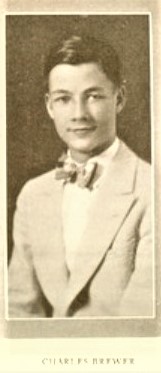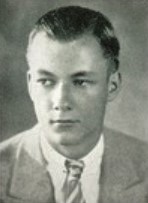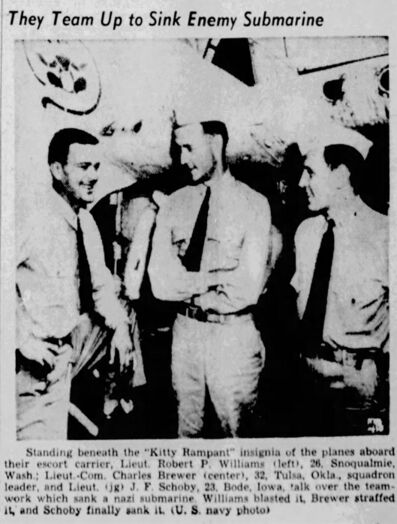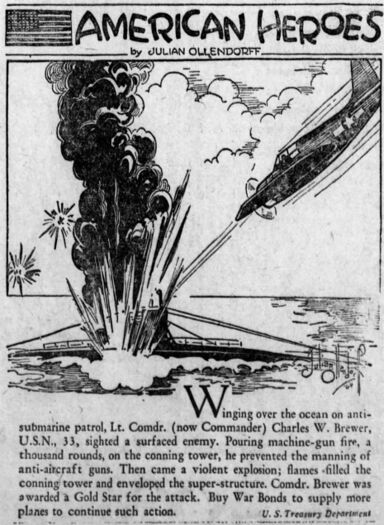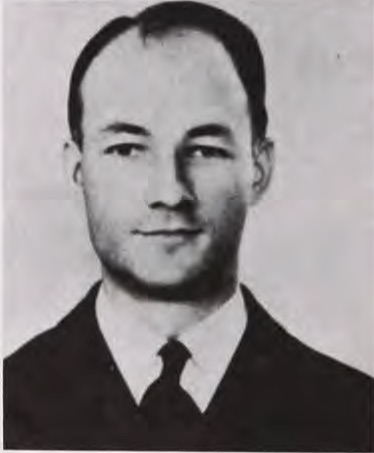CHARLES W. BREWER, CDR, USN
Charles Brewer '34
Lucky Bag
From the 1934 Lucky Bag:
CHARLES WALTER BREWER
Tulsa, Oklahoma
"Con Quien" "Charlie"
Do you mind if we boast a little of Charlie? Of course, everyone else is being praised to the skies, too, but we hope we're just a little more sincere than the rest. Oklahoma reared him, but he's borne that remarkably well, and we wouldn't ask a better roommate. We admit his failings — we wouldn't be so proud of him as a paragon; but we also feel that a stock-taking of his good qualities would show a heavy credit balance. Charlie is enough of an athlete to keep him well away from the radiator, enough of a student to get good marks without (visible) effort, and enough of a lady's man to be a consistent dragger. He's the type of friend who will lend half his pay willingly and hate to remind you of it some months hence when he needs it returned. He can be clever without being noisy, and subtle without hurting feelings. His chief gripe is the Bull Tree. He can take things seriously, but we have yet to hear him called greasy. His greatest failing as a "B" room holler-out, is a strong tendency to after-taps tooth-brushing, but he makes up for that by being quickly swept out and off about his business in the mornings.
We would wish him success in his later life were it not for the fact that we are convinced that he has it in him to succeed, and our space is used up.
Plebe Lacrosse. Hop Committee 3, 2, 1. Chairman 1. Ring Dance Committee. "B" Squad. Basketball 2. Two Stripes. Reception Committee.
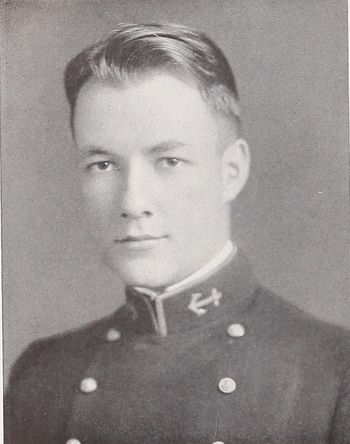
CHARLES WALTER BREWER
Tulsa, Oklahoma
"Con Quien" "Charlie"
Do you mind if we boast a little of Charlie? Of course, everyone else is being praised to the skies, too, but we hope we're just a little more sincere than the rest. Oklahoma reared him, but he's borne that remarkably well, and we wouldn't ask a better roommate. We admit his failings — we wouldn't be so proud of him as a paragon; but we also feel that a stock-taking of his good qualities would show a heavy credit balance. Charlie is enough of an athlete to keep him well away from the radiator, enough of a student to get good marks without (visible) effort, and enough of a lady's man to be a consistent dragger. He's the type of friend who will lend half his pay willingly and hate to remind you of it some months hence when he needs it returned. He can be clever without being noisy, and subtle without hurting feelings. His chief gripe is the Bull Tree. He can take things seriously, but we have yet to hear him called greasy. His greatest failing as a "B" room holler-out, is a strong tendency to after-taps tooth-brushing, but he makes up for that by being quickly swept out and off about his business in the mornings.
We would wish him success in his later life were it not for the fact that we are convinced that he has it in him to succeed, and our space is used up.
Plebe Lacrosse. Hop Committee 3, 2, 1. Chairman 1. Ring Dance Committee. "B" Squad. Basketball 2. Two Stripes. Reception Committee.
Loss
Charlie was shot down over Guam on June 19, 1944. He was Commanding Officer of Fighting Squadron (VF) 15, stationed aboard USS Essex (CV 9). He was an ace pilot, credited with 6.5 air-to-air victories.
Other Information
From researcher Kathy Franz:
Charles was born in Arapaho, Oklahoma, and attended the Arapaho schools. He graduated from Central High School in Tulsa in 1929. Hi-Y, Sophomore Class Treasurer. Manly, honest, and successful; tall, dark and popular.
His father Charley was in the banking business in Arapaho and Clinton, Oklahoma.
From the Clinton Daily News, Oklahoma, February 22, 1944:
Lt. Brewer Admits He’d Rather Fight Dust Storms Than Zeros
Lt. Charles Brewer, who shot down five Japanese planes and assisted in eliminating several others over Solomons waters, gave members of the junior chamber of commerce an air-view account of the allied invasion of Guadalcanal at their regular monthly meeting Monday night.
A fighter pilot assigned to the air groups of the Saratoga and the Enterprise on the mission, Lt. Brewer now is on duty at the Clinton naval air station.
As has been explained in numerous magazine and newspaper articles, the Japanese menace was spreading southward through the Solomons during the summer of 1942. The enemy, already reeking havoc on allied shipping lanes between the United States and Australia and other outposts, was getting ready to activate a mammoth airfield and a submarine and warship base on Guadalcanal – a further threat to allied supply lines.
An allied task force, with two carriers and numerous other ships, was sent to forestall the advance and take over the Jap base – now Henderson field. Lt Brewer was one of the pilots assigned to help with the initial attack and to assist with subsequent operations.
An army B-17 did reconnaissance work for the task force.
Attack on Aug. 7
On the morning of Aug. 7, the surprise attack took place as planned, with one part of the force attacking the beach adjacent to Henderson field and another opening up on Tulagi, across the harbor, as the Japs were eating breakfast.
Lt. Brewer was with the air group assigned to “soften up” the beach on Guadalcanal.
The element of surprise eliminated most of the air opposition in the initial attack, he said, but a great amount of enemy planes from the north, including Bougainville, provided stiff opposition later.
On one of the air attacks against the allied invaders, 22 Jap bombers and dive bombers swept in, but American fighters shot down all but one. The one enemy plane got a hit on an allied transport.
Performed Various Tasks
Lt. Brewer’s fighter group performed various tasks during the next few days, from providing cover for ships and patrol activity to strafing Japanese troops on Bougainville.
Intense fire from the ships’ big guns and American foot soldiers soon had the American flag flying over Tulagi, but the Guadalcanal battle was harder.
A few days later, Lt. Brewer shot down his first Japanese plane. His group sighted the plane far below them, spying on the movements of the American task force.
One of the lieutenant’s buddies made a pass at the plane to see what he would do. The Jap headed into a cloud, so the buddies covered the bottom of the cloud and Lt. Brewer covered its top.
The Jap came out the top and Lt. Brewer dived from him – successfully.
Finally Closed Range
“I was nervous,” he said, “My guns converge at 250 yards, but I started firing when about 800 yards. I kept firing all the way down, though, and got him when the range was right.”
Still later, Lt. Brewer and five other pilots in his group were sent out to intercept a vastly superior Japanese air group heading toward the task force – bombers with Zero fighter cover.
The group passed them very high, Lt. Brewer said, and the American fighters couldn’t catch up until the dive bombers started peeling off to make a run at the American ships.
As they peeled off, though, the American fighter planes bore in for the kill and got the first four bombers.
Happened Fast
From then on, things happened so fast they couldn’t be recorded. Lt. Brewer was credited with destroying four Jap planes in that battle, with another “possible” chalked up.
When he had used up all the ammunition and all but one gun, he headed for the Enterprise, but found that she had been hit. He was ordered to the Saratoga and was still on it when it was torpedoed by a submarine.
Damage to the Saratoga was slight, however, and it reached port with the aid of two destroyers.
Lt. Brewer said he was later declared unfit for combat fighter service, and sent back to the states.
He admits he would rather fight an Oklahoma dust storm than Jap planes.
He and his wife and small child live in Clinton.
Liberty Magazine on May 26, 1945 had an article on Air Group 15; Charlie is mentioned several times.
From the US Naval Academy Alumni Association:
CHARLIE BREWER, CLASSMATE HERO OF THE MARIANAS TURKEY SHOOT by CAPT Grayson Merrill, USN (Ret.)
Reprinted, by permission, William T. Y'Blood, Red Sun Setting: The Battle of the Philippine Sea (Annapolis, MD: Naval Institute Press, copyright 1981).
On the first day, in what was called the “Marianas Turkey Shoot”, U.S. fighters downed 219 of 326 Japanese planes sent against them. Charlie Brewer, as Carrier Air Group Commander aboard ESSEX, was lost but first shot down many enemy planes before the sun set on June 16, 1944.
While the air battle was going on, U.S. submarines sank ADM Ozawa's two largest carriers, one of them his flagship; and on the second day, dive-bombers sank a third big carrier. After that, Ozawa steered north toward Okinawa with just 35 planes left. It was the end for Japanese carrier aviation. Mitscher, of TF 58, lost 26 planes, and 3 of his ships suffered minor damage. Thanks to USNI’s book RED SUN SETTING I am able to recount Charlie’s achievements.
Fifty-five miles from the task force, Commander Charles,W. Brewer, skipper of the Essex's Fighting 5, spotted the enemy. It was 1025 and Brewer estimated the raid as twenty-four "Rats" (bombers), sixteen "Hawks" (fighters) and no "Fish" (torpedo planes). Brewer had missed some of the planes. Eight torpedo planes had been sent, along with sixteen fighters and forty-five fighter-bombers. The enemy planes were at 18,000 feet. Sixteen of the planes, identified as judys, (actually Zeke fighter-bombers) were bunched together. Two four-plane divisions of Zeke fighters were at the same altitude; one division on each flank. Bringing up the rear, between 1,000 and 2,000 feet higher, were sixteen more Zekes. These were in "no apparent pattern of sections or divisions." Behind the onrushing enemy streamed thick contrails. These atmospheric conditions would give the ships' crews a view of the battle few had seen before.
Brewer's planes were in a perfect position for a "bounce." Brewer rolled over from 24,000 feet and led his four planes in for an overhead pass. Lieutenant (jg) J. R. Carr took his four fighters in from the other side and the enemy formation was thus bracketed. The eight Essex fighters slashed into the enemy and the formation disintegrated.
Brewer picked out the formation leader as his first target. When he closed to 800 feet he opened fire and the Zeke blew up. Passing through the debris of the plane, he pulled up, shooting at another Zeke. Half a wing gone, the enemy plane plunged flaming into the sea. Brewer picked off another fighter with a no-deflection shot from about 400 feet and the plane spun into the water in flames. Clearing his tail, Brewer saw a fourth Zeke diving on him. Racking his big Hellcat around, he was quickly embroiled in a hot fight with the Zeke. Brewer was able to get on the Zeke's tail and began snapping short bursts at the violently maneuvering fighter. The Zeke pilot half-rolled, then, after staying on his back briefly, pulled through sharply, followed by barrel rolls and wingovers. These maneuvers did not save him. His plane caught fire and spiraled into the ocean.
Another observer reported Charlie’s last dog fight thusly, “Brewer and his wingman, Ensign Thomas Tarr, Jr., both hit Zekes at the same time. The enemy planes continued their dives right into the ground. After this fight the two Americans were never seen again."
His wife was listed as next of kin. Charlie was also survived by his mother, Eugenia, sister, Elizabeth, and brother, Joseph.
Photographs
From Hall of Valor:
The President of the United States of America takes pride in presenting the Navy Cross (Posthumously) to Commander Charles Walter Brewer (NSN: 0-73306), United States Navy, for extraordinary heroism in operations against the enemy while serving as Pilot of a carrier-based Navy Fighter Plane and Commanding Officer of Fighting Squadron FIFTEEN (VF-15), attached to the U.S.S. ESSEX (CV-9), in action against enemy Japanese forces in the vicinity of the Marianas Islands on 19 June 1944. Commander Brewer led component parts of his squadron to intercept Japanese airplanes attempting to reach our fleet and personally accounted for 3 of the 60 enemy planes destroyed. Later, he led the six planes remaining aboard the ESSEX to Guam and, in the face of overwhelming odds, shot down two enemy planes and contributed to the destruction or rout of the remainder. Commander Brewer's outstanding courage, daring airmanship and devotion to duty were in keeping with the highest traditions of the United States Naval Service. He gallantly gave his life for his country.
General Orders: Bureau of Naval Personnel Information Bulletin No. 334 (January 1945)
Action Date: 19-Jun-44
Rank: Commander
Company: Fighting Squadron 15 (VF-15)
Division: U.S.S. Essex (CV-9)
Legion of Merit
From Hall of Valor:
The President of the United States of America takes pleasure in presenting the Legion of Merit to Lieutenant Commander Charles Walter Brewer (NSN: 0-73306), United States Navy, for exceptionally meritorious conduct in the performance of outstanding services to the Government of the United States as Commanding Officer of Composite Squadron THIRTEEN (VC-13) during the period from March 1943 to December 1943. During this period pilots from Lieutenant Commander Brewer's squadron made attacks which resulted in the sinking of several enemy submarines, thereby contributing materially to the success of the campaign against the enemy. The success of this squadron is attributed directly to the outstanding leadership, devotion to duty, professional knowledge and ability of Lieutenant Commander Brewer, and reflects great credit upon the United States Naval Service.
Action Date: March 1943 - December 1943
Rank: Lieutenant Commander
Company: Composite Squadron 13 (VC-13)
Distinguished Flying Cross
From Hall of Valor:
The President of the United States of America takes pleasure in presenting the Distinguished Flying Cross to Lieutenant Commander Charles Walter Brewer (NSN: 0-73306), United States Navy, for extraordinary achievement while participating in aerial flight as a Pilot in Composite Squadron THIRTEEN (VC-13). At about 1530 on 13 July 1943, two U.S. Navy Fighter Planes and two U.S. Navy Torpedo Bombers strafed and bombed a German submarine discovered fully surfaced. Lieutenant Robert Pershing Williams, U.S.N.R., made a torpedo bombing run which seriously disabled the submarine and prevented it from submerging. Lieutenant Commander Brewer and Lieutenant Julius Rueben Brownstein, USN, Fighter Pilots, strafed all anti-aircraft gun crew on board the disabled submarine. These attacks were so successful as to permit a depth charging bombing attack by a U.S. Navy Torpedo Bomber, piloted by Lieutenant, Junior Grade, James Frank Sehoby, which resulted in the complete destruction of the submarine.
General Orders: Commander in Chief Atlantic: Serial 03365 (November 10, 1943)
Action Date: July 13, 1943
Rank: Lieutenant Commander
Battalion: Composite Squadron 13 (VC-13)
From Hall of Valor:
The President of the United States of America takes pride in presenting a Gold Star in lieu of a Second Award of the Distinguished Flying Cross (Posthumously) to Lieutenant Commander Charles Walter Brewer (NSN: 0-73306), United States Navy, for extraordinary achievement while participating in aerial flight as pilot of a United States Navy Fighter Plane in offensive action against an enemy submarine on 20 October 1943. Lieutenant Commander Brewer was flying on an anti-submarine patrol flight when the pilot of a companion plane sighted a surfaced enemy submarine. Immediately on having his attention attracted to the U-Boat, Lieutenant Commander Brewer commenced an effective strafing attack. Concentrating accurate machine gun fire on the conning tower, he prevented the enemy's anti-aircraft guns from being manned. During the strafing attack over a thousand rounds of machine gun bullets were fired at close range at the enemy resulting in a violent explosion and flame which filled and enveloped the conning tower and superstructure. The aggressiveness and accuracy displayed by Lieutenant Commander Brewer in making a deadly strafing attack, thereby damaging and preventing the hostile U-Boat from taking up defensive anti-aircraft fire against the attacking bomber, were in keeping with the highest traditions of the United States Naval Service.
General Orders: Commander in Chief Atlantic: Serial 1869 (May 25, 1944)
Action Date: October 20, 1943
Rank: Lieutenant Commander
From Hall of Valor:
The President of the United States of America takes pleasure in presenting a Second Gold Star in lieu of a Third Award of the Distinguished Flying Cross to Lieutenant Commander Charles Walter Brewer (NSN: 0-73306), United States Navy, for extraordinary achievement while participating in aerial flight. Commander Brewer, as Commanding Officer of Fighting Squadron FIFTEEN (VF-15), led his squadron in almost continuous air operations against the enemy from 11 June 1944 until he was missing in action on 19 June 1944. On 19 June 1944, in the approximate position Lat. 17-31 N and Long 144-10 E he led the second of two group air attacks on an enemy convoy which resulted in the destruction of about 40,000 tons of enemy merchant shipping, destroyed at least one destroyer and three escort vessels, and damaged numerous others. His timely coordination and inspiring leadership were in a large part responsible for this major catastrophe to the enemy merchant fleet. His initiation of and persistence in the devastating strafing attack resulted in such major damage to an enemy destroyer that it completely disintegrated on the spot. Immediately after landing aboard upon the completion of this action, Commander Brewer was informed that a sizeable enemy force was engaged in combat with our planes near the Island of Guam. Although at that time, only seven fighting planes remained on board that were in commission, Commander Brewer immediately drew up a task organization and was himself catapulted with the other six planes and proceeded to the assistance of those of our aircraft in the vicinity of Guam. Upon arrival there he found that his seven planes were the only friendly planes remaining in the vicinity to engage with the numerically superior enemy. His quick planning and timely execution enabled this small group to either destroy or rout all enemy planes then present. During this engagement he himself accounted for two enemy planes. Unfortunately, of the original group of seven, only five returned to the ship, Commander Brewer's plane being one of those missing.
Action Date: June 11 - 19, 1944
Rank: Lieutenant Commander
Company: Fighting Squadron 15 (VF-15)
The "Register of Commissioned and Warrant Officers of the United States Navy and Marine Corps" was published annually from 1815 through at least the 1970s; it provided rank, command or station, and occasionally billet until the beginning of World War II when command/station was no longer included. Scanned copies were reviewed and data entered from the mid-1840s through 1922, when more-frequent Navy Directories were available.
The Navy Directory was a publication that provided information on the command, billet, and rank of every active and retired naval officer. Single editions have been found online from January 1915 and March 1918, and then from three to six editions per year from 1923 through 1940; the final edition is from April 1941.
The entries in both series of documents are sometimes cryptic and confusing. They are often inconsistent, even within an edition, with the name of commands; this is especially true for aviation squadrons in the 1920s and early 1930s.
Alumni listed at the same command may or may not have had significant interactions; they could have shared a stateroom or workspace, stood many hours of watch together… or, especially at the larger commands, they might not have known each other at all. The information provides the opportunity to draw connections that are otherwise invisible, though, and gives a fuller view of the professional experiences of these alumni in Memorial Hall.
July 1934
October 1934
January 1935
April 1935
October 1935
January 1936
April 1936
July 1936
LTjg John Duke '26
CAPT Ernest Pollock '28
LTjg William Pennewill '29
LTjg Gilbert Carpenter '30
LTjg Lance Massey '30
LTjg William Sisko '31
LTjg Charles Crommelin '31
January 1937
LT John Duke '26
CAPT Ernest Pollock '28
LTjg William Pennewill '29
LTjg Gilbert Carpenter '30
LTjg Lance Massey '30
LTjg William Sisko '31
1LT Harold Larson '31
LTjg Charles Crommelin '31
ENS Harold Von Weller '33
April 1937
CAPT Ernest Pollock '28
LTjg William Pennewill '29
LTjg Gilbert Carpenter '30
LTjg Lance Massey '30
1LT Harold Larson '31
LTjg Charles Crommelin '31
ENS Harold Von Weller '33
September 1937
LTjg Vernon Hain '31 (Bombing Squadron (VB) 4)
LTjg George Hutchinson '32 (Bombing Squadron (VB) 4)
LTjg Archibald Greenlee '32 (Scouting Squadron (VS) 41)
ENS William Hulson '36 (USS Ranger)
ENS John Daub, Jr. '36 (USS Ranger)
January 1938
LTjg George Hutchinson '32 (Bombing Squadron (VB) 4)
LTjg Archibald Greenlee '32 (Scouting Squadron (VS) 41)
ENS William Hulson '36 (USS Ranger)
ENS John Daub, Jr. '36 (USS Ranger)
July 1938
January 1939
October 1939
June 1940
ENS Richard Sampson '38 (USS Helena)
ENS Richard Helm '39 (USS Helena)
ENS Paul Thompson '40 (USS Helena)
ENS Cyrus Radford, Jr. '40 (USS Helena)
November 1940
CDR William Sample '19
LT William Pennewill '29
LT Finley Hall '29
LT John Yoho '29
LT Lance Massey '30
LT George Bellinger '32
LT Martin Koivisto '32
LT John Spiers '32
LT Daniel Gothie '32
LT Dewitt Shumway '32
LT Albert Major, Jr. '32
LTjg John Phillips, Jr. '33
ENS Frank Peterson '33
LTjg Walker Ethridge '34
CAPT Floyd Parks '34
LTjg Charles Ware '34
LTjg Frank Whitaker '34
LTjg Philip Torrey, Jr. '34
LTjg George Nicol '34
LTjg Victor Gadrow '35
LTjg John Powers '35
LTjg Allan Edmands '35
LTjg Roy Krogh '36
LTjg Porter Maxwell '36
LTjg Richard Hughes '37
LTjg Frank Henderson, Jr. '37
LTjg John Thomas '37
LTjg John Boal '37
ENS Harry Howell '38
ENS Eric Allen, Jr. '38
ENS James Ginn '38
ENS Oswald Zink '38
ENS Frank Case, Jr. '38
ENS Howard Fischer '38
ENS Edmundo Gandia '38
ENS Charles Reimann '38
ENS Howard Clark '38
ENS Roy Hale, Jr. '38
ENS Leonard Thornhill '38
ENS Osborne Wiseman '38
ENS John Eversole '38
ENS Jep Jonson '38
ENS Roy Green, Jr. '38
ENS Marion Dufilho '38
2LT James Owens '38
ENS William Brady '38
ENS Charles Anderson '38
ENS Carl Holmstrom '38
ENS Charles King '38
2LT John Maclaughlin, Jr. '38
ENS William Tate, Jr. '38
2LT Douglas Keeler '38
ENS Harry Bass '38
ENS John Kelley '38
ENS John Erickson '38
ENS William Lamberson '38
ENS Donald Smith '38
ENS Frank Quady '38
ENS Richard Crommelin '38
ENS Robert Seibels, Jr. '38
ENS Alphonse Minvielle '38
April 1941
LT William Pennewill '29
LT Finley Hall '29
LT John Yoho '29
LT William Sisko '31
LT George Bellinger '32
LT Martin Koivisto '32
LT John Spiers '32
LT Archibald Greenlee '32
LT Daniel Gothie '32
LT Albert Major, Jr. '32
LTjg John McCormack, Jr. '33

The "category" links below lead to lists of related Honorees; use them to explore further the service and sacrifice of alumni in Memorial Hall.
